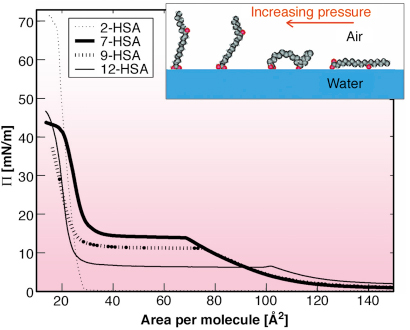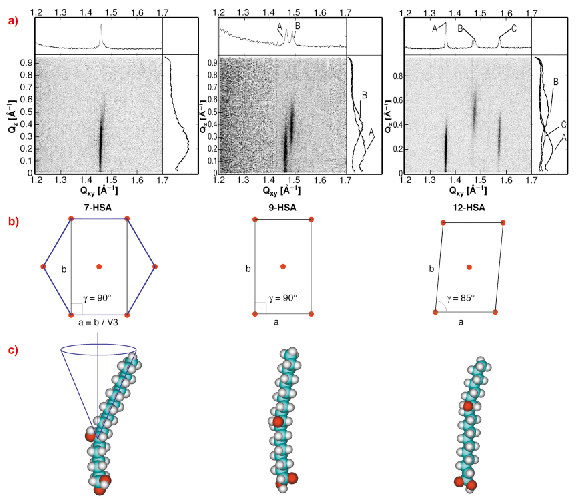- Home
- Users & Science
- Scientific Documentation
- ESRF Highlights
- ESRF Highlights 2006
- Soft Condensed Matter
- Effect of OH group position on the 2D crystalline structure of Langmuir monolayers of hydroxystearic acids
Effect of OH group position on the 2D crystalline structure of Langmuir monolayers of hydroxystearic acids
The family of hydroxystearic acids (HSA) is involved in many fundamental processes and applications: from a proposed role in biological cell apoptosis to waxes and cosmetics. In all applications, the role of the chain hydroxyl substituent is deemed essential, albeit not understood. This is due to the complexity of competing interactions in the most common morphological situations of interest (membranes, films, interfaces). In particular, HSA molecules at the air-water interface present an interesting bi-competitive adsorption between primary and secondary hydrophilic groups on either end of an alkyl chain, which –depending on the position of the second hydrophilic group– may lead to a sharp transition from an expanded phase to a crystalline condensed morphology as surface pressure is increased. In Figure 50 we show the Langmuir compression isotherms for different HSAs, and a sketch of the molecular conformations at the air-water interface.
 |
|
Fig. 50: Langmuir compression isotherms for different HSAs, indicated in the legend, at room temperature. Inset: a sketch of the molecular conformation at the air-water interface as a function of the surface pressure. |
In this highlight we report quantitative results on the microscopic structure of 2D crystalline phases of several HSAs, which, particularly for the case of the important 12HSA, may give important indications on its structural and morphological role in biological systems. The measurements were performed at beamline ID10B on a series of hydroxystearic acids in which the position of the secondary competing hydrophilic group was varied along the whole extent of the alkyl chain from the position 2- (i.e. close to the primary hydrophilic group) to the positions 7- 9- and 12-, the latter being the compounds most frequently studied in the literature. We obtained direct microscopic evidence, by synchrotron radiation reflectometry and grazing-incidence diffraction, that the position of the secondary hydrophilic group not only strongly influences the phase diagram as determined by compression isotherms and ellipsometry, but also induces different crystallisation patterns in the 2D system of the Langmuir monolayer. In particular we report for the first time the existence of a turning point in the effects of the hydroxyl position on the monolayers structure at 7-HSA.
In Figure 51a, we show the GID diffraction patterns for the different HSA molecules indicated in Figure 51c, as measured on the ID10B beamline. For each HSA, the GID pattern was measured at a pressure immediately above the plateau in the ![]() -A isotherm of that particular compound. In Figure 51b the direct space crystallographic structures obtained from GID data are shown, while Figure 51c shows the assumed molecular conformation, in particular, for the 7-HSA, the proposed rotor phase is indicated.
-A isotherm of that particular compound. In Figure 51b the direct space crystallographic structures obtained from GID data are shown, while Figure 51c shows the assumed molecular conformation, in particular, for the 7-HSA, the proposed rotor phase is indicated.
In summary, our results show that as the position of the second OH group is moved further away from the carboxylic polar head, the crystalline symmetry is decreased: 2-HSA does not seem to form true crystalline layers and shows a pseudo-hexagonal arrangement of molecular units; 7-HSA was found to have true hexagonal symmetry, which most likely is in a free rotor phase; 9-HSA was found to have rectangular symmetry; and a true oblique cell was found for 12-HSA. Also, the average molecular tilt with respect to the normal to the water surface increases as symmetry is lowered.
Finally, by X-ray reflectivity from monolayers at high surface pressure we could confirm the structures identified by GID and we have been able to locate the layer formed by the second hydrophilic group, which was shown to form a 2D network of hydrogen bonds, which in 12-HSA is located 0.9 nm out of the water surface.
 |
|
Fig. 51: a) GID diffraction patterns for the HSA molecules. For each HSA, the GID pattern was measured at a pressure immediately above the plateau in the |
Principal Publication and Authors
L. Cristofolini (a), M.P. Fontana (a), C. Boga (b), O. Konovalov (c), Langmuir 21, 11213 (2005).
(a) CRS-SOFT & Physics Dept.Uni Parma (Italy)
(b) Chemistry Dept. Uni Bologna (Italy)
(c) ESRF



